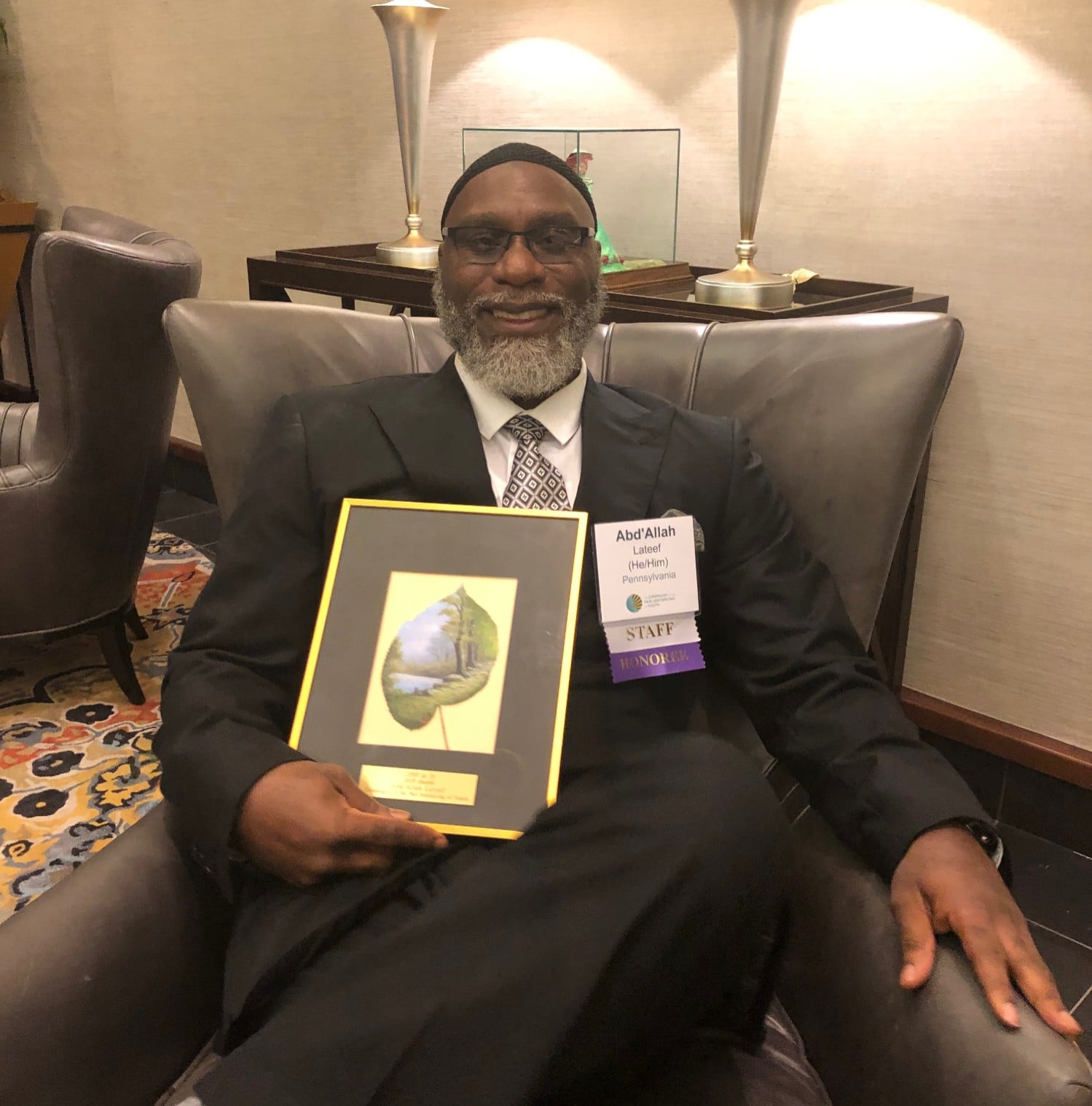As the holidays approached, I found myself in one of the most financially precarious situations I had ever experienced. It had been nearly a year since an unknown person or persons infiltrated my home network, locking me out of my verified Twitter account and taking control of several old email accounts. But what seemed like a random act of maddening but largely harmless hostility was much more.
For months, I discovered, someone had been quietly siphoning money from my financial accounts. By the end of November I was nearly broke, my credit cards were maxed out, and I had begun leafing page-by-laborious-page through bank and credit card statements.
“We’re fucked,” I told my girlfriend.
Then one cold, damp morning, as I was making a list of the items I was willing to sell to make December’s rent, I was contacted by a close friend I had not heard from in some time.
His name is Abdul Lateef. He is a convicted murderer. He is also one of the most gracious and humble human beings I know.
“What can I do to help?” he asked.
When I first met Abdul, whose birth name was Aaron Phillips, he was locked up for life for a strong-arm robbery gone wrong. The total take? About $60, which was spent on crack cocaine.
He had been incarcerated for over 25 years by the time we met in a drab prison visiting room in 2012. He was not even allowed to handle the cash I brought for his lunch. I had to order his food and place a prepaid card in the vending machine for him.
Yet on this day, as a steady rain fell outside the coffee shop where we met near his North Philadelphia home, this “violent felon”—who, as a devout Muslim, was practicing zakat, or charity, one of the five pillars of Islam—insistently stuffed $120 in my hand.
“That’s a gift, you don’t owe me anything. Hopefully I can help more next month,” he said.
I struggled to hold back tears. We parted with a heartfelt embrace.
Life for a Teenage Crime
Abdul’s legal troubles date back to 1986, two months after his 17th birthday. Before then, he had struggled to make friends as a youth due to a speech impediment that made him easy prey for bullies. So he latched on to the company of an older homeless man from the neighborhood. In a sad irony, Abdul says he did not even use cocaine. He just wanted to help his friend.
The victim “was grabbed, his wallet was removed from his pocket, and he was knocked down to the floor.”
Lured by the promise of quick cash, Phillips, as he then was, and his older accomplice set upon the home of an elderly man with the intention of stealing his wallet. Neither carried a weapon.
According to court documents, the victim “was grabbed, his wallet was removed from his pocket, and he was knocked down to the floor.” When police arrived they found him walking but complaining of pain in his hip. An X-ray showed he had suffered a borderline fracture of his femur. Despite the risks of using general anesthesia on a patient of advanced age, doctors decided to operate.
Eighteen days later, the victim was dead. The medical examiner ruled that the death was probably caused by a bowel obstruction, complicated by having surgery at such an advanced age. But the assault was identified as an aggravating factor.
The two assailants were quickly tracked down and arrested.
Phillips was charged with felony murder—which then carried a manadatory life sentence for juvenile offenders. (His adult accomplice, who Abdul says pressured him into participating, faced the same charge but struck a deal with the authorities to testify against Abdul; he was released after less than a decade. He has since passed away.)
Instead of accepting a plea deal like his older and more streetwise co-defendant, Phillips relented to pressure from his parents to fight the case. What his attorney left out, however, was what was at stake if he lost.
He did lose. In January 1988, he was convicted of second-degree murder and sentenced to mandatory life imprisonment without the possibility of parole. He still wasn’t even old enough to drink legally.
He was completely resolved to the reality that he would die without ever being a free man again.
I learned of his case in 2012, while writing a series of articles on juvenile life without parole. We began corresponding regularly by letter. Within a year, I was making frequent visits to the State Correctional Facility at Frackville in northeastern Pennsylvania.
I had visited many people in prison, but something struck me about this gentle man who was born the same year as me. A mutual respect developed, which soon grew beyond a professional relationship into a friendship. Our regular conversations ranged through issues from prison policy to my impending divorce. Abdul, who married and converted to Islam while in prison, offered wise words of counsel.
At the same time, he was completely resolved to the reality that he would die without ever being a free man again.
The Supreme Court Intervenes
When the Supreme Court of the United States ruled in Miller v. Alabama (2012) that mandatory life sentences for offenders under the age of 18 violate the Eighth Amendment’s prohibition against cruel and unusual punishment, it left it to the states to determine retroactivity.
The Court revisited that issue two years later—forcing a small cluster of states (including Pennsylvania) that refused to apply the ruling to impacted people who had already exhausted their appeals to resentence all juvenile lifers.
Abdul Lateef was the first person to be resentenced and freed from Montgomery County, a suburban community adjacent to Philly, under that ruling.
I was one of a handful of supporters who sat in the courtroom on the day a judge re-sentenced him to time served. And on October 10, 2017, my friend took a step he never thought he would: He walked out of prison without shackles and rejoined society.
“Prison by its very nature robs a man of tenderness and affection. It breeds harshness and insensibility.”
He had spent 30 years behind bars at that point—almost twice the length of his life pre-incarceration.
“Prison by its very nature robs a man of tenderness and affection,” he had written me in a letter in October 2016. “It breeds harshness and insensibility. My wife restores and replenishes my spirit.”
I’ll admit I was scared for him. How would he make it in today’s fast-paced world? (To my surprise he swiftly joined Facebook, and Twitter. He’s now getting ready to launch a podcast.)
Abdul, who always accepted culpability for his crime but also recognized the excessiveness of his sentence, has thrived in the years since he was released. He now lives with his wife and stepdaughter, and travels frequently to speak about the injustice of juvenile life sentences for advocacy groups.

The Collateral Misery of Prohibition
As I drove away from meeting him in December, I was humbled by his generosity, and his courage in the face of such extreme adversity put my own troubles in perspective.
But for the first time I realized that in 1986, Aaron Phillips and the man he assaulted were, in very different ways, both collateral damage in a war for which neither enlisted.
I reflected on how many other people, convicted of a wide range of crimes, are similarly victims of inadequate support or treatment, and of a pitiless system.
The illegal drug economy is particularly elusive and difficult to study. Participants include people engaged in illicit activity as well as those tasked with preventing it. The crimes associated with this world—and often produced by the laws and enforcement that define it—include not only those that are explicitly drug-related but also ancillary activities, from money laundering and larceny to illegal gun sales, extortion, assault and murder.
The vast majority of people who traverse this network, including more than a few law enforcement officers, will come in contact with the criminal justice system—but many fall outside of measures of the drug war’s reach. This makes assessing the full extent of the drug war’s impact on incarceration rates all but impossible.
If anything, we understate the connections between prohibition and mass incarceration and suffering.
But the collateral consequences of drug prohibition stretch well beyond our overly simplistic interpretation of “drug-related crime.” For instance, studies show that juvenile offenders engaged in “income producing crimes” are more likely to drop out of school and face adult arrest than youth arrested for crimes like vandalism. We may never know, however, how many poor youths drop out of school to sell drugs, parlaying that early introduction to the subculture into convictions for other, non-drug felonies.
Once you factor in the multi-generational, marginal consequences of prohibition—including collateral sanctions for drug convictions; diversion of resources from drug treatment to law enforcement; the trickle-down effects of imprisonment on families and communities; the racist police profiling that comes hand-in-hand with “narcotics” enforcement; and the violence engendered by the unstable illicit markets that result—it’s easy to see that if anything, we understate the connections between prohibition and mass incarceration and suffering.
Would Abdul’s story have been different had his crime not occurred during a decade that saw some of the most aggressive drug policing ever known? It’s possible.
What is beyond doubt is a point that bears on many current debates around expungement, and voting, housing, educational and employment rights for people with felony convictions.
Because Abdul’s story of endurance through 30 years, and the man he became, demonstrate the humanity of “violent felons,” the power of redemption—and the monstrous injustice of taking a whole lifetime of hope away from anyone.
Photographs courtesy of Abdul Lateef.





Show Comments